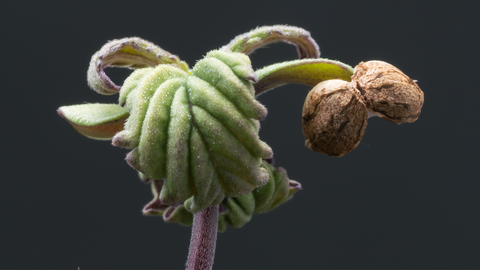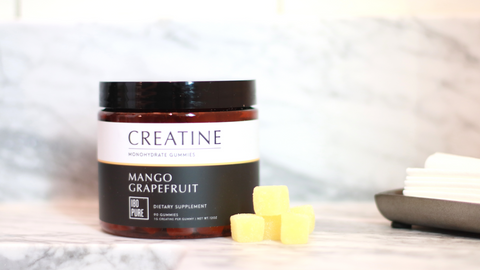WHAT IS CBD?
CBD stands for the word Cannabidiol (pronounced can·na·bi·di·ol). Merriam Webster defines it as: "a crystalline, nonintoxicating cannabinoid C21H30O2 found in cannabis and hemp that is sometimes used medicinally."
Over 100 of these compounds, known as cannabinoids, that have been found in the Cannabis Sativa plant. (And, for the sake of this article, we'll only be talking about and referencing cannabinoids naturally found in hemp.)
There are a few things that can make our description of CBD extra confusing. For example, sometimes we use CBD as a way to describe both a product and a chemical. Because cannabinoids were so new just a few years ago to a vast majority of the public, the acronym CBD became a ‘popular’ way to describe products containing CBD. Most of the time, when we’re talking about using CBD – people are describing the use of some kind of an oil or lotion – a product. The acronym became a simplified way of describing a broader, more complex category of cannabinoids. Not just the singular chemical cannabinoid of CBD.
So, as our collective understanding about cannabinoids grows, so does our recognition of other increasingly common cannabinoids in the hemp plant, that can be used or found in hemp based products. Remember, there are over 100 known cannabinoids found in the hemp plant. There is CBD, CBG, CBA, CBN, etc. We describe them as either a major or minor cannabinoids, depending on how much of that single chemical is naturally found in the hemp plant.
HOW DOES CBD WORK?
CBD, like any other cannabinoids, doesn’t work on its own within the human body. When CBD molecules enter the bloodstream, they work to reach the endocannabinoid system. This system is in the DNA of every human and animal. The endocannabinoid system, (known as the ECS for short) is the reason CBD products can help support our everyday wellness goals. Cannabinoids interact with the ECS to enhance and support it’s proper function, and balance.
All humans and animals have this ECS system, it’s in our DNA but wasn’t discovered until the 1960’s and we’re still learning much about it. One of the ways the body maintains its physical and emotional balance is through this system, which why maintaining it’s health has become so important. The purpose of the ECS is to work with, communicate, and regulate wellness with a variety of systems in our body. These systems include the Nervous System, Cardiovascular System, Endocrine System, Digestive System, Immune System, Respiratory System, and more. Because the ECS is connected to and communicates with so many of our body systems, it has a magnified impact on our bodies.
HOW DOES THE ECS WORK?
Here’s the actual definition of the Endocannabinoid System (from Wikipedia): “The endocannabinoid system (ECS) is a biological system composed of endocannabinoids, which are endogenous lipid-based retrograde neurotransmitters that bind to cannabinoid receptors (CBRs), and cannabinoid receptor proteins that are expressed throughout the vertebrate central nervous system (including the brain) and peripheral nervous system. The endocannabinoid system remains under preliminary research, but may be involved in regulating physiological and cognitive processes, including fertility,[1] pregnancy,[2] during pre- and postnatal development,[3] various activity of immune system,[4] appetite, pain-sensation, mood, and memory, and in mediating the pharmacological effects of cannabis.[5][6]“
The ECS has two main Cannabinoid receptors: CB1 and CB2. These receptors are spread all throughout the entire body. We can think of these receptors like ‘locks’, which are in need of a ‘key’ to release them and allow them to work. So, also within our bodies are these naturally produced molecules, which are like ‘keys’ that specifically ‘unlock’ the power of the CB1 and CB2 receptors. These molecules are called: Anandamide and Arachidonoyl Glycerol (2AG). These are Endocannabinoids. They’re molecules our human bodies naturally make to work with, and ‘unlock the power’ of our CB1 and CB2 receptors.
The ‘locks’ and ‘keys’ send signals to each other, and help control millions of chemical reactions that occur within the body. This is what forms the primary chemistry and/or function of the Endocannabinoid System. This complex and expansive system of receptors is a vital, cell-signaling body system.
HOW DOES CBD WORK WITH THE ECS?
The hemp plant contains Phyto-cannabinoids – which essentially are cannabinoids that come from a plant. CBD is just one of the cannabinoids in the hemp plant. CBD, and all the other cannabinoids found in the hemp plant, mimic our human-made Endocannabinoids. When these cannabinoids are introduced to the body, it can’t distinguish between them, because they mimic our naturally produced ones so well. So when hemp is introduced to the body, it gets a fresh flood of cannabinoids that interact with the CB1 and CB2 receptors.
Plant based cannabinoids, similar to our human produced endocannabinoids – fit as a ‘key’ to our CB1 and CB2 receptors and ‘unlock’ their power – promoting health and balance to our body. When you’re using hemp derived CBD, this is how it’s working in your body. And, why it can have such an incredible and compounded effect. And honestly, this is why so many people are finding success with using CBD products, even though they don't understand how it's working.


